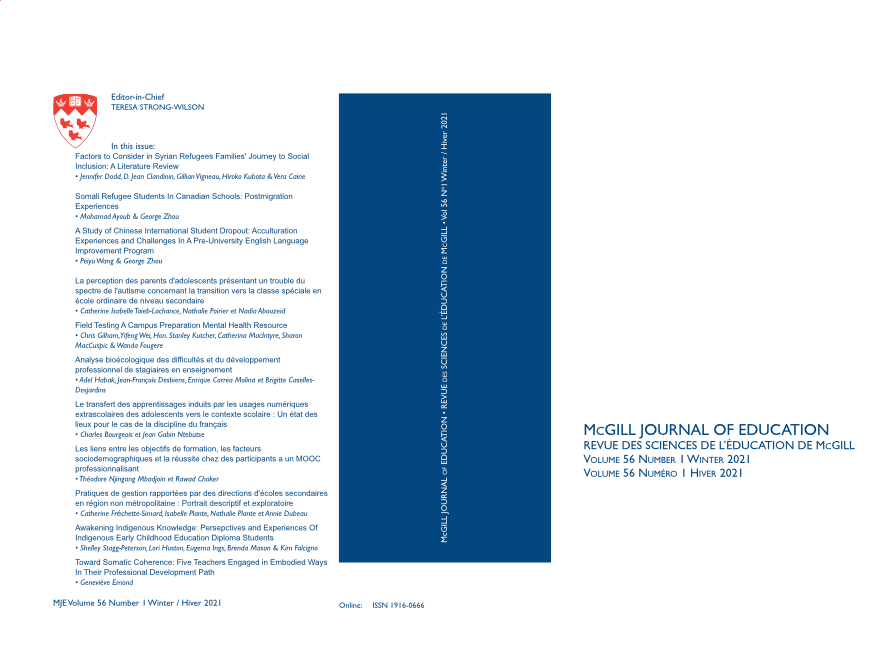Toward Somatic Coherence: Five Teachers Engaged In Embodied Ways In Their Professional Development Path
Keywords:
body, embodiment, professional development, somatic education, teaching, somatic coherence, reflective practiceAbstract
According to Johnson (2007), learning and teaching arise from a human being’s bodily experience in relationship with others and the environment (embodiment). Many teachers perceive and mobilize their bodies in rather unconscious ways. Becoming conscious of their perceptions can help them teach. It can also influence their internal/external coherence (Korthagen, 2004), link between sensations, intentions, and actions. Five elementary teachers participated in a study meant to look at their bodily learning processes, based on a phenomenological methodology (van Manen, 2014) and using somatic approaches (Eddy, 2016). Data analysis shows that they underwent body consciousness learning processes with various effects on their teaching, many posited at a relational level (with students) and all accompanied by a changing perception of self.
References
Butler, J. (1993). Bodies that matter: On the discursive limits of sex. Routledge.
Cooper Albright, A. (2019). How to land: Finding ground in an unstable world. Oxford University Press.
Dewey, J. (1949, 1938). Experience and education. McMillan.
Eddy, M. (2016). Mindful movement: The evolution of the somatic arts and conscious action. University of Chicago Press.
Emond, G. (2018). L’apprentissage de la conscience de la corporéité chez des enseignantes et des formatrices et ses influences perçues sur la cohérence interne-externe de leur pratique. [Embodiment consciousness learning processes for teachers and adult educators and their perceived influences on internal/external coherence of their practice]. [Unpublished doctoral thesis]. Université du Québec à Montréal.
Emond, G. (2015). Enseigner avec son corps : Étude exploratoire sur le corps vécu d’enseignants du primaire en formation initiale en contexte de stage. [Teaching with our body: Exploratory study on the lived body of elementary school student-teachers while in practicum]. [Master’s thesis in Dance]. Université du Québec à Montréal.
Emond, G. & Rondeau, K. (2019). Accompagner l’apprentissage de la conscience de la corporéité en contexte de formation à l’enseignement. [Mentoring teachers’ embodiment awareness learning]. In K. Rondeau & F. Jutras (Eds.), L’accompagnement du développement personnel et professionnel en éducation : S’accompagner, accompagner, être accompagné. March, (pp. 69–86). Presses de l’Université du Québec (PUQ).
Emond, G. & Fortin, S. (2016). Perceptions du corps vécu d’enseignantes-stagiaires au primaire, un outil de cohérence en processus de professionnalisation. [Lived body perceptions among elementary school students-teachers, a coherence tool in the professionalization process]. Éducation et formation. e-305, March, 77–86.
Ergas, O. (2017). Reconstructing “education” through mindful attention: Positioning the mind at the center of curriculum and pedagogy. Palgrave & McMillan.
Estola, E. & Elbaz-Luwisch, F. (2003). Teaching bodies at work. Curriculum Studies, 35(6), 697–719. https://doi.org/10.1080/0022027032000129523
Giles, D. (2010). Developing pathic sensibilities: A critical priority for teacher education programmes. Teaching and Teacher Education, 26(8), 1511–1519. https://doi.org/10.1016/j.tate.2010.05.007
Gilligan, C. (1993, 1982). In a different voice: Psychological theory and women’s development, 2nd Ed. Harvard University Press.
Green, B. & Hopwood, N. (Eds.). (2015). The body in professional practice, learning and education: Body/practice. Springer International.
Hanna, T. (1986). What is somatics? Somatics: Magazine-Journal of the Bodily Arts and Sciences, V(4), 4–8.
Hunter, L. (2011). Re-embodying (preservice middle years) teachers? An attempt to reposition the body and its presence in teaching and learning. Teaching and Teacher Education, 27(1), 187–200. https://doi.org/10.1016/j.tate.2010.07.016
Johnson, M. (2007). The meaning of the body: Aesthetic of human understanding. University of Chicago Press.
Kepner, J. (1993). Body process: Working with the body in psychotherapy. Jossey-Bass.
Klein, S. (2008). Holistic reflection in teacher education: Issues and strategies. Reflective Practice: International and Multidisciplinary Perspectives. 9(2), 111–121. https://doi.org/10.1080/14623940802005384
Korthagen, F. & Vasalos, A. (2005). Levels in reflection: Core reflection as a means to enhance professional growth. Teachers and Teaching: Theory and Practice, 11(1), 47–71. https://doi.org/10.1080/1354060042000337093
Korthagen, F. (2004). In search of the essence of a good teacher: Towards a more holistic approach in teacher education. Teaching and Teacher Education, 20(1), 77–97. https://doi.org/10.1016/j.tate.2003.10.002
Lachance, J., Emond, G. & Vinit, F. (2018). Learning to be a sensitive professional: A life-enhancing process grounded in the experience of the body. Adult Education Quarterly, 69(1), 24–41. https://doi.org/10.1177%2F0741713618807752
Miller, J., Nigh, K., Binder, M., Novak, B. & Crowell, S. (Eds.). (2019). International handbook of holistic education. Routledge.
Miller, J. & Nigh, K. (Eds.). (2017). Holistic education and embodied learning (Current perspectives in holistic education). Information Age Publishing.
Noddings, N. (1984). Awakening the inner eye intuition in education. Teachers College Press.
Palmer, P. J. (1998). The courage to teach: Exploring the inner landscape of a teacher’s life. Jossey-Bass.
Paul, M. (2009). Accompagnement. [Mentoring]. Recherche et formation, 62, 91–107 (129–139).
Ragoonaden, K., Emond, G., Rugira, J.-M. & Rondeau, K. (2019, April 6). Enriching holistic research practices: building mindful research learning communities [Presentation]. Panel Holistic Education Group, American Educational Research Association (AERA), Toronto, Canada.
Roche, L. & Gal-Petitfaux, N. (2012). La médiation audio-visuelle pour former à l’expérience corporelle de l’enseignant d’EPS en situation de classe. [Audiovisual mediation to help physical education teachers grasp their physical experience in teaching situation]. STAPS: Revue internationale des sciences du sport et de l'éducation physique, 98(4). 95–111.
Sheets-Johnstone, M. (2015). Embodiment on trial: A phenomenological understanding. Continental Philosophy Review, 48(1), 23–39. https://doi.org/10.1007/S11007-014-9315-Z
van Manen, M. (2014). Phenomenology of practice: Meaning-giving methods in phenomenological research and writing. Left Coast Press.
Vermersch, P. (2014, 2003). L’entretien d’explicitation. [The explicitation interview]. (8th ed.). ESF.
Winther, H., Naesggard Grontved, S., Kold Gravesen, E. & Ilkjaer, I. (2015). The dancing nurses and the language of the body: Training somatic awareness, bodily communication, and embodied professional competence in nurse education. Journal of Holistic Nursing, 33(3), 182–192. https://doi.org/10.1177/0898010114561063
Published
How to Cite
Issue
Section
License
Copyright (c) 2022 McGill Journal of Education / Revue des sciences de l'éducation de McGill

This work is licensed under a Creative Commons Attribution-NonCommercial-NoDerivatives 4.0 International License.



